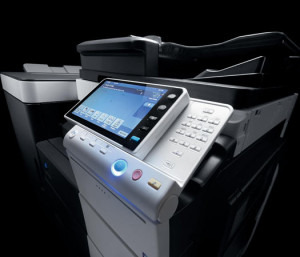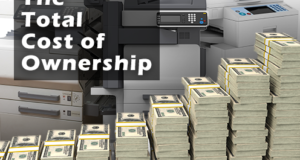Getting a new office machine is quite often a necessity, but there are considerations to be made when upgrading, or even purchasing your first unit(s). Calculating your return on investment (ROI) isn’t terribly difficult if you understand a few basic concepts, and you have access to the relevant numbers. The problem is, most people don’t understand how a new MFP or printer can actually save money over the long haul or increase productivity in the office. I’ll try to walk you through the steps to understanding how to determine if a new model (or even an upgraded model) can actually make you money and affect your bottom line.
In addition to the monthly expense calculations of a copier, you want to take into account the maintenance or support costs as well as your consumables. But that’s not all. There’s the convenience factor of having a newer, faster, more capable device at your disposal—or an additional unit to reduce “traffic jams” in the office. There’s also improvements in your office staff productivity, your output and a more optimized workflow that results in your ability to get more work accomplished throughout the day. Multiply that across your office staff, and you could be looking at thousands of dollars when annualized.
Calculating ROI on MFPs Using Energy Consumption
 One thing I didn’t mention was energy consumption. While these costs could factor into the decision, the fact is that manufacturers of modern MFPs have put literally millions of dollars into the development of energy-efficient machines. When you think about it, the fact that your copier, printer, scanner and fax machine can be all rolled into one is a good indicator that energy use shouldn’t play too big of a roll in making an upgrade decision. We’re light years ahead of the curve in that department compared to just a decade or two ago. In addition to pure energy savings, the new machines coming out feature better toner coverage, and duplex functions cut down on your paper and supply costs. The total cost of ownership on these business machines has never been lower.
One thing I didn’t mention was energy consumption. While these costs could factor into the decision, the fact is that manufacturers of modern MFPs have put literally millions of dollars into the development of energy-efficient machines. When you think about it, the fact that your copier, printer, scanner and fax machine can be all rolled into one is a good indicator that energy use shouldn’t play too big of a roll in making an upgrade decision. We’re light years ahead of the curve in that department compared to just a decade or two ago. In addition to pure energy savings, the new machines coming out feature better toner coverage, and duplex functions cut down on your paper and supply costs. The total cost of ownership on these business machines has never been lower.
Better Workflow
In addition to the impressive document management capabilities of these new MFPs, workflow in an office can be increased in a number of ways. Some of these ways can save you a lot of money, while others will simply result in greater convenience for your employees—which itself, often leads to greater productivity through increased job satisfaction and employee retention.
Increasing Your Job Tracking Abilities
If you’ve got an older MFP or copier, chances are you’re still dealing with a machine that’s largely limited to its core functions: printing, scanning, copying and faxing. That’s fine—it is, after all, why you likely purchased the machine. Newer models, however, are increasing your capabilities for advanced productivity by allowing for each user to quickly and easily log into the machine—virtually or in-person—and provide user and project IDs for all initiated print jobs. This means you can better document and track billable activities for your projects. We’ve seen many companies add new line items to their invoices because they can now track exactly what jobs or users are tied to the output or usage of a particular device.
Optimizing Workflow Through Specialization
When you have to do a lot of color projects and black and white projects, or you have particular jobs that require advanced finishing—like stapling or saddle-stitching…this can really tie up an office if you allocate a single machine to do it all. Run a single larger job, and you’ve prevented the rest of the staff for using a machine for 20 minutes (or more). Calculating ROI on MFPs can take into account an increased number of machines in your office which can yield productivity gains. These are gains that can really optimize the way your employees work and change how quickly they can complete jobs and jump onto new ones.
Average Your Maintenance Fees or Leverage for Better Ones
There are always opportunities to leverage the use of multiple machines in order to reduce your overall maintenance fees and consumable fees with copiers and MFPs. By showing loyalty to a single dealer or service provider, you can often secure a single “umbrella” rate for all of your color and black and white copying and printing needs. This can lower your costs as compared to a piecemeal approach to service. Take care in how you arrange for these contracts and business relationships, and you may end up with a dealer for life that you can trust to meet your needs both now and in the future.
Staggering Your Upgrades and Purchases to Stay Current
Nearly everyone can benefit from the increases in technology each generation of MFP brings, but there are techniques to benefit the most. Calculating ROI on MFPs using a staggered purchase plan can really pay off. Staggering your purchases and/or leases to always have a machine that’s less than 2-3 years old is a technique I’ve recommended for years. Let me illustrate this in two ways. Here’s what happens when I purchase two machines at the same time, each with the same 5-year lease and then upgrade them again after 5 years:
Year 1 – Machine 1 (new), Machine 2 (new)
Year 2 – Machine 1 (fairly new), Machine 2 (fairly new)
Year 3 – Machine 1 (not as new), Machine 2 (not as new)
Year 4 – Machine 1 (used), Machine 2 (used)
Year 5 – Machine 1 (well used), Machine 2 (well used)
Year 6 – 2nd-gen Machine 1 (new), 2nd-gen Machine 2 (new)
Year 7 – 2nd-gen Machine 1 (fairly new), 2nd-gen Machine 2 (fairly new)
Year 8 – 2nd-gen Machine 1 (not as new), 2nd-gen Machine 2 (not as new)
Year 9 – 2nd-gen Machine 1 (used), 2nd-gen Machine 2 (used)
Year 10 – 2nd-gen Machine 1 (well used), 2nd-gen Machine 2 (well used)
But look at what happens when I stagger my leases by just a little bit, taking a five-year lease on one product and a three-year lease on another:
Year 1 – Machine 1 (new), Machine 2 (new)
Year 2 – Machine 1 (fairly new), Machine 2 (fairly new)
Year 3 – Machine 1 (not as new), Machine 2 (not as new)
Year 4 – Machine 1 (used), 2nd-gen Machine 2 (new)
Year 5 – Machine 1 (well used), 2nd-gen Machine 2 (fairly new)
Year 6 – 2nd-gen Machine 1 (new), 2nd-gen Machine 2 (not as new)
Year 7 – 2nd-gen Machine 1 (fairly new), 2nd-gen Machine 2 (used)
Year 8 – 2nd-gen Machine 1 (not as new), 2nd-gen Machine 2 (well used)
Year 9 – 3rd-gen Machine 1 (new), 3rd-gen Machine 2 (new)
Year 10 – 3rd-gen Machine 1 (fairly new), 3rd-gen Machine 2 (fairly new)
In the first example, we have two machines that last for five years before being replaced by new machines. At the end of ten years, you have two second-generation machines that are ready for replacement.
In the second example, we have one machine on a five-year lease and another on a three-year lease. Then, when the machines renew, we reverse the order and place the replacement machines on the opposite time period lease term arrangement. At the end of ten years, we are using two third-generation machines that are both still fairly new. Using this method, you have upgraded in a way that you have been able to enjoy three full generations of technology—and at a much faster rate than if both leases were set for the same five-year duration. The additional cost on the three-year lease term is the trade-off, but often the gains in productivity and capability more than offset the cost impact. This is particularly true when the machines are used in different applications: color/finishing and general purpose, for example.
Conclusion
Depending upon your industry, Calculating ROI on MFPs may give you even more reasons why upgrading your machine would make sense. If you plan on handling health care, legal or other government-regulated documents, for example, you will need to have some of the latest software and hardware in order to maintain compliance. Even if your needs are more traditional, however, upgrading your MFP or copier may indeed be the smart move for you company.
If you’ve got other ideas or considerations about Return on Investment that we didn’t cover here, please feel free to drop us a line at feedback@copierguide.com—we’d love to hear from you!
 CopierGuide Copier and Multifunction Printer Leases and Reviews
CopierGuide Copier and Multifunction Printer Leases and Reviews






I want quotation for black and white xerox/printer machine with return on investment calculation….
and cartridge life and maintenance cost…..
our monthly requirement is 3500 sheets /month single side
please provide a quotation with return on investment calculation…. we required it for our company it is urgent